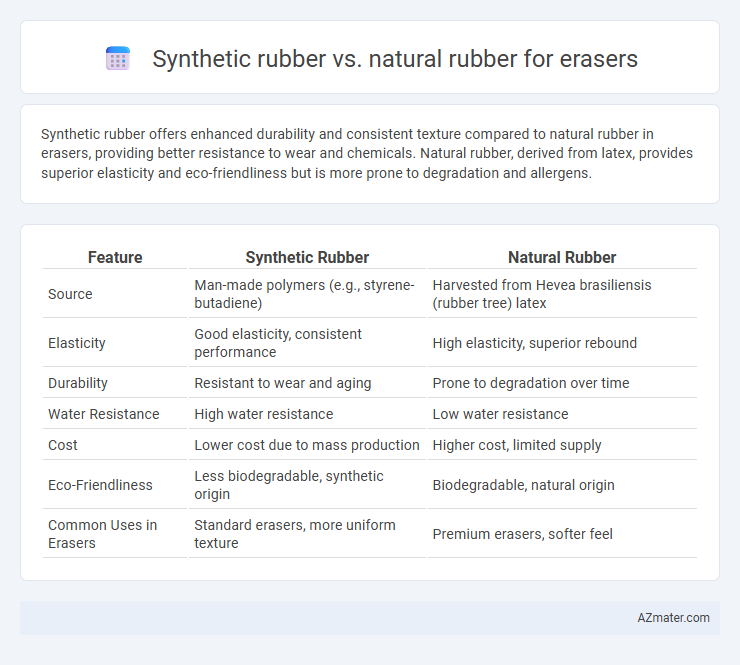Synthetic rubber offers enhanced durability and consistent texture compared to natural rubber in erasers, providing better resistance to wear and chemicals. Natural rubber, derived from latex, provides superior elasticity and eco-friendliness but is more prone to degradation and allergens.
Table of Comparison
| Feature | Synthetic Rubber | Natural Rubber |
|---|---|---|
| Source | Man-made polymers (e.g., styrene-butadiene) | Harvested from Hevea brasiliensis (rubber tree) latex |
| Elasticity | Good elasticity, consistent performance | High elasticity, superior rebound |
| Durability | Resistant to wear and aging | Prone to degradation over time |
| Water Resistance | High water resistance | Low water resistance |
| Cost | Lower cost due to mass production | Higher cost, limited supply |
| Eco-Friendliness | Less biodegradable, synthetic origin | Biodegradable, natural origin |
| Common Uses in Erasers | Standard erasers, more uniform texture | Premium erasers, softer feel |
Introduction to Rubber Types for Erasers
Natural rubber, derived from latex sap of Hevea brasiliensis trees, offers high elasticity and resilience, making it a traditional choice for erasers. Synthetic rubber, produced from petroleum-based polymers like styrene-butadiene or nitrile, provides enhanced durability, chemical resistance, and uniformity in eraser manufacturing. Both rubber types are engineered to optimize abrasion properties and erasing efficiency, influencing texture, softness, and durability in eraser products.
Composition and Production of Synthetic Rubber
Synthetic rubber used in erasers primarily consists of polymers such as styrene-butadiene rubber (SBR) and butadiene rubber, produced through the polymerization of monomers derived from petroleum byproducts. Its production involves processes like emulsion polymerization or solution polymerization, enabling controlled properties like elasticity and abrasion resistance. In contrast, natural rubber is harvested as latex from rubber trees and contains cis-1,4-polyisoprene, offering distinct organic composition but varying consistency compared to synthetic alternatives.
Natural Rubber: Sources and Characteristics
Natural rubber used in erasers primarily comes from the latex of Hevea brasiliensis trees, mainly cultivated in Southeast Asia. It offers superior elasticity, resilience, and biodegradability compared to synthetic rubber, making it environmentally favorable. The high tackiness and fine particle structure of natural rubber allow for effective graphite and charcoal removal without damaging paper surfaces.
Eraser Performance: Synthetic vs Natural Rubber
Synthetic rubber erasers typically offer superior durability and better resistance to heat and chemicals compared to natural rubber erasers, resulting in longer-lasting performance and cleaner erasing. Natural rubber erasers excel in softness and flexibility, providing gentle erasing with less paper abrasion but tend to wear down faster and may leave residue. The choice between synthetic and natural rubber impacts eraser efficiency, with synthetic variants favored for precision and longevity, while natural rubber is preferred for traditional, sensitive applications.
Durability and Lifespan Comparison
Synthetic rubber erasers exhibit superior durability compared to natural rubber due to their enhanced resistance to wear, heat, and chemicals, extending their effective lifespan during frequent use. Natural rubber erasers tend to degrade faster as they are more susceptible to environmental factors like oxidation and humidity, leading to crumbling and reduced performance over time. This makes synthetic rubber the preferred choice for erasers requiring long-lasting durability and consistent quality.
Environmental Impact and Sustainability
Synthetic rubber used in erasers primarily derives from petroleum-based sources, leading to higher carbon emissions and non-renewable resource depletion compared to natural rubber. Natural rubber, harvested from Hevea brasiliensis trees, offers a biodegradable alternative with a lower environmental footprint and supports sustainable agroforestry practices. However, natural rubber production can contribute to deforestation and biodiversity loss if not managed responsibly, making certified sustainable sourcing crucial for minimizing ecological impact.
Cost-Effectiveness and Market Trends
Synthetic rubber erasers are generally more cost-effective than natural rubber due to lower raw material and production costs, making them preferred in large-scale manufacturing. Market trends indicate a growing demand for synthetic rubber erasers driven by their consistent quality, durability, and availability, especially in industrial and educational sectors. Despite natural rubber's biodegradability advantages, synthetic variants dominate the eraser market due to cost efficiency and performance reliability.
Allergies and User Safety Considerations
Synthetic rubber erasers are less likely to cause allergic reactions compared to natural rubber, which contains proteins that can trigger latex allergies in sensitive users. User safety considerations favor synthetic rubbers because they generally lack the allergenic proteins found in natural rubber, making them safer for individuals prone to contact dermatitis or latex sensitivity. Selecting synthetic rubber erasers reduces the risk of allergic responses and ensures a safer, hypoallergenic option for all users.
Applications in Art, School, and Office Supplies
Synthetic rubber erasers offer consistent performance and enhanced durability, making them ideal for precise erasing tasks in art studios and professional offices. Natural rubber erasers provide a softer touch and are preferred in schools for basic pencil corrections due to their biodegradable properties and gentle surface interaction. Both types support various applications, with synthetic variants excelling in detailed artistic work and natural rubber favored for eco-friendly, everyday use in educational settings.
Future Innovations in Eraser Materials
Synthetic rubber offers enhanced customization in molecular structure, leading to erasers with improved durability, stain resistance, and precision in eraseability. Future innovations include bio-based synthetic rubbers derived from renewable resources, reducing environmental impact while maintaining performance. Advances in nanotechnology are also expected to create erasers with superior abrasion control and longer lifespan compared to traditional natural rubber options.

Infographic: Synthetic rubber vs Natural rubber for Eraser
 azmater.com
azmater.com